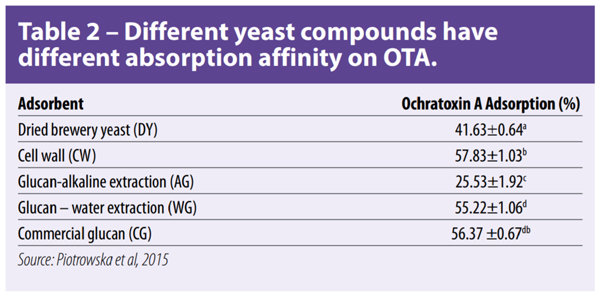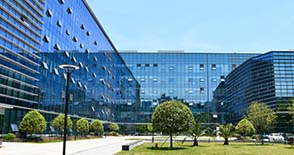Nov 19, 2021
by Li Han
Organic absorber-yeast cell wall-have totally different mechanism and features than inorganic clay minerals on mycotoxin management. It’s proved an effective supplement to expanding absorbing spectrum of various inorganic absorbers.
Developing optimally efficient adsorbents is usually a challenge for animal nutritionist because of the various types of mycotoxins, as well as adsorbent materials. The most concerning mycotoxins to human health and livestock are aflatoxins, ochratoxins, deoxynivalenol (DON, vomitoxin), T-2/HT-2 toxins, zearalenone, and fumonisins. Among them, the contamination of aflatoxins can easily be tackled by using mineral absorbents including aluminosilicates, diatomite, and sepiolite, or activated carbons. However, these compounds are relatively ineffective toward other mycotoxins including ZEN, DON and OTA.
Also, the binding between inorganic sorbents and mycotoxins is demonstrated to be not robust and easy to dissociate in the acidic environment of GI tract and requires high levels of incorporation to achieve efficiency. Which, in turn, will impact the bioavailability of minerals and trace elements in feed and raise the risk of dioxins and heavy metals. In the last decade, other types of binders have been studied. Among them, organic compounds of yeast origin have been proposed as an alternative solution because of its natural advantage on these aspects.
Absorbing affinity
Many previous studies have confirmed the absorption affinity of intact yeast cells or yeast cell wall fractions on mycotoxins. And, according to our study, the extracted cell wall fractions of yeast have higher absorbing affinity than brewer yeast which contains intact yeast cells (Table 1). The same result been observed in the study of Piotrowska et al in 2015 (Table 2), who compared different yeast and yeast extract fractions on OTA absorption. The addition of yeast cell walls to feed can help to reduce aflatoxin residues in milk. Besides reducing aflatoxin residues in milk, yeast cell wall fractions have a higher adsorption affinity for ZEN, DON and OTA. Furthermore, the binding between yeast cell wall and mycotoxins does not dissociate in a low pH environment. Those differences in the absorbing spectrum and dissociating rate is because of the different mechanism of action. Inorganic clays bind mycotoxins as the presence of hydroxyl or carbonyl groups that allow ionic interactions.


Van der Waals bonds
For yeast cell wall, β-D-glucans are the critical component responsible for the complexation of mycotoxins, and that the reticular organization of β-D-glucans and the distribution between β-(1,3)- D-glucans and β-(1,6)-D-glucans play a major role in the efficacy. Weak hydrogen and van der Waals bonds are involved in the complexation of mycotoxins by β-D-glucans, thus indicating that the chemical interaction is more of “adsorption type” than “binding type”.
Controlling the production process
When compared to inorganic absorbers, the yeast cell wall has a lower impact on feed nutrients, such as vitamins B1 and B2. However, many studies have demonstrated that dietary addition of yeast cell wall could provide comprehensive benefits on stimulating immunity, protecting intestinal health, as well as production performance.
Interestingly, our research shows that the commercial YCW products collected from different manufacturers, production processes and/or different biomass production, have different effect on mycotoxin absorption. This difference has a direct relation to the integrity of reticular organisation of β-D-glucans and the distribution between β-(1,3)- D-glucans and β-(1,6)-D-glucans. This finding is consistent with previous study which was done by Piotrowska et al in 2015 (Table 2). We can see from this study that yeast cell wall fractions and commercial glucan have the highest absorption rate of OTA. While the alkaline extracted-glucan have the lowest as the space structure and reticular organisation been destroyed. Brewer’s yeast has intact space structure of cell wall, but the lack of beta-glucan and binding sides lead to moderate absorbing rate of OTA. These studies indicate that it is very important for our manufacturers to control the production process to keep integrate space structure as well as a reasonable portion of polysaccharide fraction of the yeast cell wall.
Fighting the toxic effects of mycotoxins
In view of this and to achieve higher absorption rate, Angel Yeast produce cell walls from primarily fermented yeast biomass by using specially selected enzymes under controlled processes. The final product YeaMOS has an integrate structure, balanced content of polysaccharide fraction as well as more exposed binding sites.
As yeast cell wall have different features than inorganic compounds and could provide comprehensive benefits for animals. To combine inorganic compounds with organic yeast cell wall is a good idea against the toxic damage of various mycotoxins. Based on this idea, we developed the product Biobon that blends inorganic clay and YeaMOS. The comparative research shows that it has the highest absorption rate on not only AFB, but also the ZEN, DON and OTA.
| Published by Li Han Engineer of Animal Nutrition Division |
About Angel Animal Nutrition:
Fubon is a brand of Angel Animal Nutrition. Fubon is committed to developing natural, efficient microbial feed derived from yeast with Angel's leading technology in yeast industry, providing the best service solutions for the nutrition and health in animals. Angel Animal Nutrition creates value for global feed and animal agriculture customers through continuously upgraded products and professional services.
About Angel:
Angel Yeast Company is a high-tech listed company specializing in yeast and biotech. Product business covers Yeast and Baking, Yeast Extract-Savoury, Nutrition & Health and Biotechnology fields. It is one of the world's leading companies in the yeast industry. Angel has 12 holding subsidiaries and provides products and services for more than 150 countries and regions.
Press contact:
ANGEL YEAST CO.,LTD
Address: 168 Chengdong Avenue, Yichang, Hubei 443003, P. R.China
Tel:+86-717-6369520, 6369558
Fax:+86-717-6370680
email: aie@angelyeast.com








